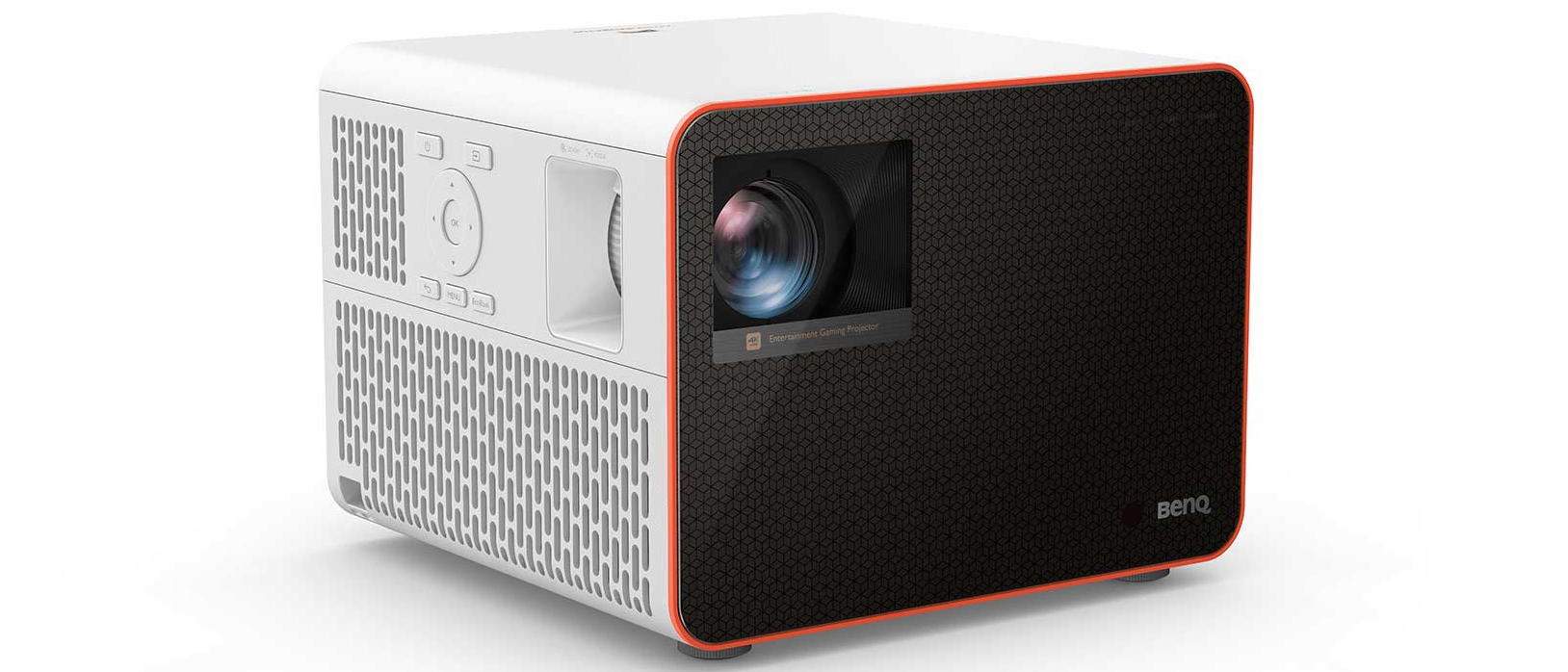Sound+Image Verdict
Gamers get low latency from BenQ’s new UHD projector, while movie fans get outstanding colour delivery and a new entry to the DLP mirror-flipping family.
Pros
- +
Excellent colour and imaging
- +
High brightness
- +
Easy set-up & Android TV
Cons
- -
Lacklustre built-in speakers
- -
Best results via HDMI sources
Why you can trust What Hi-Fi?
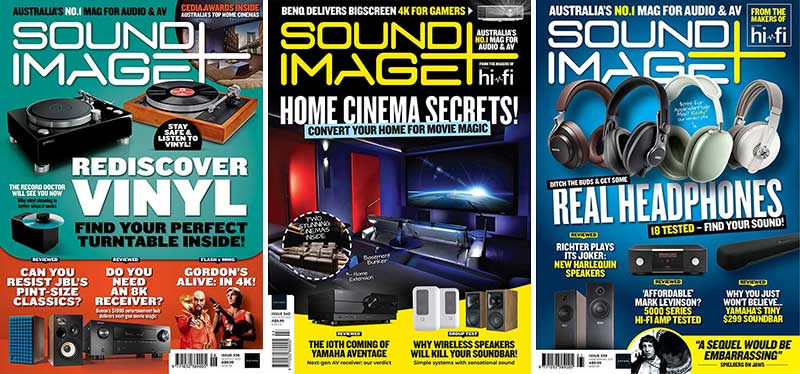
This review originally appeared in Sound+Image magazine, one of What Hi-Fi?’s Australian sister publications. Click here for more information on Sound+Image, including digital editions and details on how you can subscribe.
Read What Hi-Fi?'s global, star-rated review of the BenQ X3000i.
There’s an exciting first in this latest projector from BenQ, which is headlined as a ‘console gaming projector’ – part of the company’s ‘X’ gaming series – but which for our purposes at Sound+Image can also considered to be built for entertainment, coming as it does with consumer 4K resolution, HDMI inputs, built-in speakers and even an Android TV stick to give it a smart streaming interface.
It also looks rather different. As with the recent roll-to-aim GV30 projector, BenQ’s product design team has worked overtime to deliver something notably novel but also practical, so that here we have a rectangular box with curved edges, rather than the usual bulging projector shape. A line of orange surrounds the black frontage from which the lens peers not centrally, but from the top left.
Despite its friendly appearance, this is a serious projector. It delivers full Ultra High Definition via four-flash DLP, and it employs a 4LED light source which adds a bonus blue/green LED to the previous 3LED ecosystem, thereby promising to boost brightness and colour luminance, while also extending lifespan. It has all the adjustments you’d expect to optimise its home cinema performance, with the exception of motion smoothing.
The X3000i is designed so that it can sit on a table, but it can also work upside down, whether conventionally ceiling-mounted or – since it has no controls requiring access on its top surface – simply plonked upside down on a high shelf... though that would be a fairly deep shelf.
Pictures of the X3000i don’t really suggest its full size: it is 27cm wide and 20cm high, reaching back 26cm in depth. It can fire upwards from a table, or downwards from a ceiling, and usefully all its controls and air vents are on the sides, so it can be ‘hush-boxed’ easily, not that it turned out to need any hushing.
But that ‘first’ which initially intrigued us is nothing so large, indeed it is a mere inch long, and resides deep within the projector. It’s the latest 4K-capable DMD chip from Texas Instruments, the DLP650TE.
The magic mirrors
This is not the first time BenQ has been quick to market with a DLP chip. This DLP650TE has, to our knowledge, only appeared elsewhere in one other projector, a Panasonic business model retailing at nearly AU$10K. The new chip is not native 4K, as used on far larger, more expensive projectors, notably Sony’s, but it follows TI’s method of delivering multiple ‘hits’ or ‘flashes’ per frame to build up the full UHD resolution.
The latest hi-fi, home cinema and tech news, reviews, buying advice and deals, direct to your inbox.
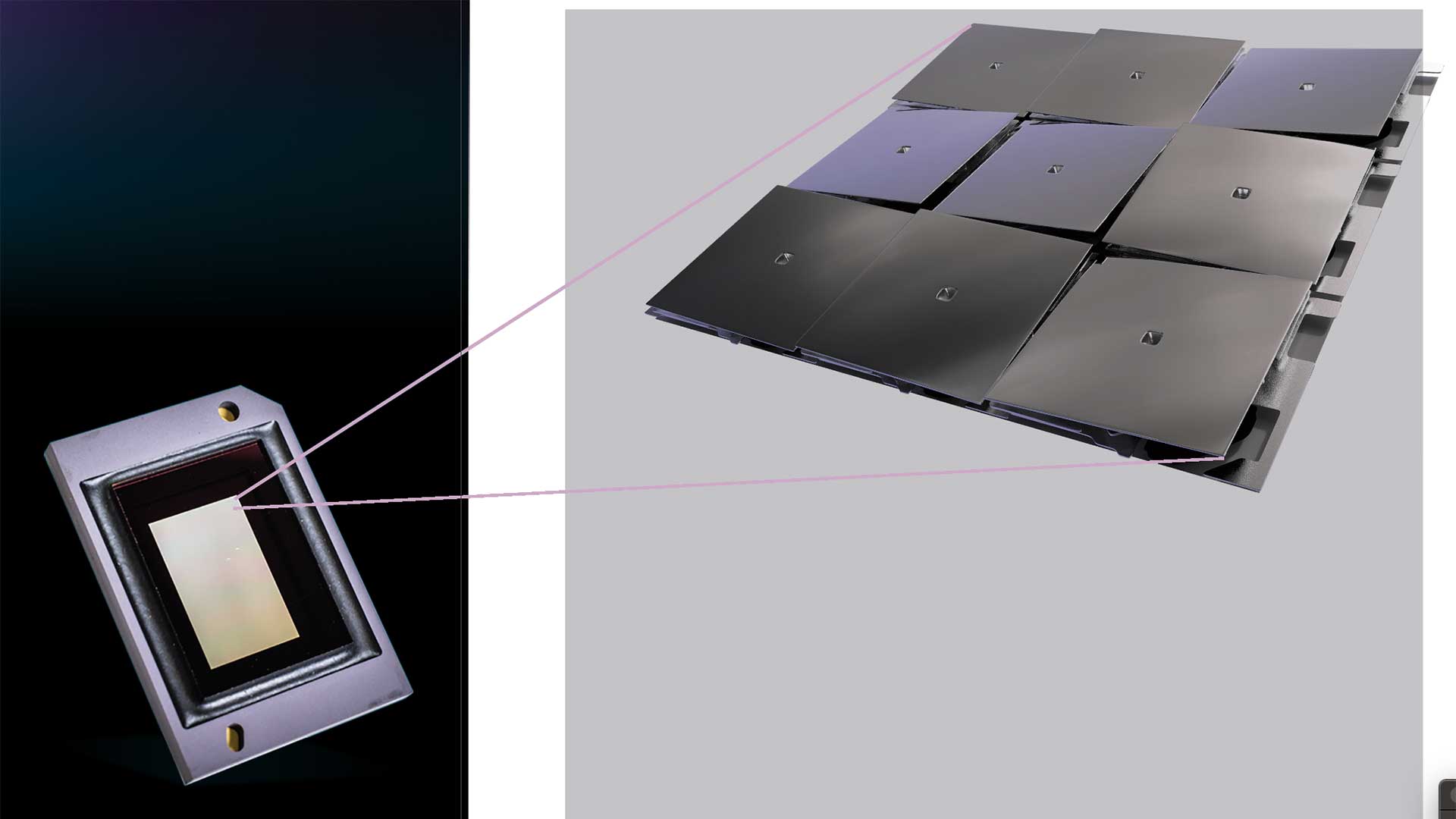
It’s always worth revisiting how the DMD (digital micromirror device) used in DLP projection works, because it seems so very remarkable. First developed by Texas Instruments in 1987 and released as the first ‘chip’ in 2000, these devices use millions of tiny aluminium mirrors that can be mechanically flipped to point in different directions.
The DLP650TE DMD in this projector has a native resolution of 1920 x 1080, with all those tiny mirrors pivoted four times each frame to allow sequential delivery of four sections of a full Ultra High Definition (3840 x 2160) image to the screen.
Beneath the mirrors is a two-dimensional array of 1-bit CMOS memory cells, and the deflection angles of the micromirrors are individually controlled by changing the address voltage of those cells.
TI has long made these DMD chips in a variety of physical sizes, but the key ones for home cinema use have been either 0.47 of an inch or 0.65 (or 0.66) of an inch. Larger would be better in quality terms if it allowed a larger pixel size, which could deliver more light, and so less noise.
Projection technology: DLP650TE 1920x1080 four-flash DMD delivering 3840x2160; 4LED light engine
Throw ratio: 1.15-1.5 (100”@ 2.5m; 1.3 zoom)
Brightness: 3000 lumens
Inputs: 3 x HDMI, USB power, RS-232, 12V trigger
Outputs: HDMI eARC, optical digital, stereo 3.5mm
Latency: 16.67ms (4K@60Hz, 1080p@60Hz); 8.33ms (1080p/120Hz); 4.16ms: (1080p@240Hz)
Dimensions (whd): 272 x 197 x 259mm
Weight: 6.4kg
But hitherto, the 0.65/66-inch DMDs kept the individual mirrors at the same 5.4-micrometre size as on the smaller DMDs, and instead squeezed in more of them. And in terms of those multiple ‘flashes’, we never understood the geometry of the larger DMDs.
The operation of the smaller DMDs is easy to visualise. The native resolution of 0.47-inch DMDs has been 1920×1080, which is then delivered four times per frame to yield 3840×2160 UHD resolution. Easy maths.
But the 0.66-inch DMD commonly used for home cinema until now had a native resolution of 2716×1528, and this hit the screen twice per frame. Good luck working out the geometry of that procedure. We’ve never understood how two hits of that resolution could yield UHD without some weird overlapping requiring radical pre-processing; it seems akin to the audio no-no of non-integer resampling.
Perhaps TI thought the same, as the new DLP650TE retains the easier geometry of four-flash 1920×1080 to build up UHD pictures on screen, and it uses the additional space to have larger mirrors, now 7.6μm in pitch. And that yields a potential 98% increase in mirror area.
Together with the DMD chip itself, there is a display controller and a motor driver. So this DMD chipset is comprised of the DLP650TE DMD, the DLPC7540 display controller, and the DLPA100 power management and motor driver.
4LED light engine
The larger micromirrors are not the only way this projector promises to achieve higher brightness (so also improving on the slightly limited contrast that some have noted from the smaller chips). There’s another brightness boost here in the choice of light engine, a 4LED light source.
4LED adds an additional blue ‘pump’ LED to the 3LED ecosystem; as with the first blue LED its light is converted to green via ceramic phosphors in order to amplify the overall output of green light. Green output is here boosted by 40%, which brings a claimed 8%-12% increase in overall brightness when compared to a 3LED projector.

The result is 3000 lumens of illumination, and also better colour control. The X3000i claims to cover 100% of the DCI-P3 wide colour gamut, so of course goes significantly beyond the full Rec. 709 colour gamut (DCI-P3 is 26% larger than Rec.709).
Accurate colour has long been a BenQ strength, especially in delivering excellent out-of-the-box performance in this regard.
Its ‘CinematicColor’ processes employ precise nanometer-level references for its colour-wheel angles and coating. But here BenQ also has a way to keep the colours accurate in the longer term. It notes that 4LED projection systems can gain a greenish-blue tint after some 20,000 hours of use, so this projector has an auto colour-calibration system which should keep colour temperature accurate.
Embedded colour sensors detect the LED’s status, then calibrate and correct for accurate WRGBYCM even after long-term use. (It’s worth noting that 20,000 hours is enough to watch, say, all three Lord of the Rings extended films each week for 33 years, so this may not be a problem you’ll face early.)
With reference to its dedication to colour, BenQ recently became the first projector manufacturer in the world to earn Pantone SkinTone Validation, under “the first science-based system” for matching and reproducing human skin tones.
Gaming angles
This projector’s greater brightness and more accurate colours already provide strengths for gamers, but of course for many games it’s input lag that is critical, so you don’t lose crucial milliseconds that allow you to shoot them before they shoot you.
The X3000i’s input lag is quoted at 4.16ms at 240Hz in 1080p, though more realistically for console gaming at 16.67ms for either 4K/60 or 1080p/60, half that for the limited number of console games that run at 4K/120 or 1080/120. That’s excellent in projector terms, though gaming monitors (such as BenQ’s own) can get down to 1ms or even less.
The X3000i not only has low input lag by projector terms, BenQ is further keen to help gamers simplify the process of getting what they need, by making selection of gaming modes easy and quick. To this end the remote control supplied in Australia (and in the US, EU, Japan and home territory Taiwan) has changed the function of two of its top three buttons compared with remotes sent out to ‘other regions’.
In ‘other regions’ these buttons work like the ones for the little GV30 portable, doing an instant check for focus and keystone geometry, and automatically righting any wrongs (the Quick Start Guide we were supplied still showed this option in its instructions). But in Australia those buttons have been replaced by one for ‘dynamic stereo enhancement’ (don’t get too excited; see below), and one to access gaming modes directly.

There are three of these ‘preset’ game modes: for role-playing games (RPG), first-person shooters (FPS), and sports games (SPG). All of them invoke a ‘fast mode’ which bypasses enough processing to ensure those minimum response times, while differences between modes lie in colour choice and audio processing.
RPG provides ‘cinematic images’ for gamers, while also claiming “surround sound – like what experienced [sic] in movie theaters – to enhance the heart-pumping score and deep roar of the game’s monsters coming from all around”. But ‘all around’ and ‘surround’ are clearly not possible from a stereo pair of 5W speaker modules; the only surround you’ll hear will be if the projector is positioned behind you! So this is a laudably rare slip into extravagant PR from a company which prides itself on accuracy.
‘Sports’ offers bright and true colours aimed at ‘photo realism’, together with “true-to-life broadcasting voices”.
FPS sensibly enhances details in dark scenes more than the other game modes, while for sound it aims to highlight ambient sounds such as footsteps and gunshots; it calls this a “surround effect”, but again, not a real one.
Note that in all these scenarios, the use of the fast mode deactivates auto-keystone.
In its specs the X3000i is listed as “compatible” with Playstations 5, 4, 4 Pro and Slim, XBoxes One X and One S, and the Nintendo Switch. So what happens if you connect a PS3, say?
“A PS3 can definitely work with X3000i as a ‘normal’ source,” BenQ Australia’s Bejoy Babu confirmed to us. “It’s just the fact PS3 users cannot use X3000i at its full potential... for example the maximum resolution given out by PS3 is Full HD, whereas X3000i can support up to 4K signals.”
So compatibility should really be universal with HDMI sources; the ‘compatibility’ list is just showing those which will deliver the best gaming experience.
Setting up
We took advantage of the X3000i’s ability to be ceiling-mounted to position the projector. It has a throw ratio of 1.15 to 1.5, and a zoom of 1.3×, so that with a position just over 3.2 metres from our screen the zoom lever on the side could vary the screen size from around 98 inches up to 133 inches diagonal. We used a 100-inch screen, so had a considerable brightness bonus over the maximum stretch.
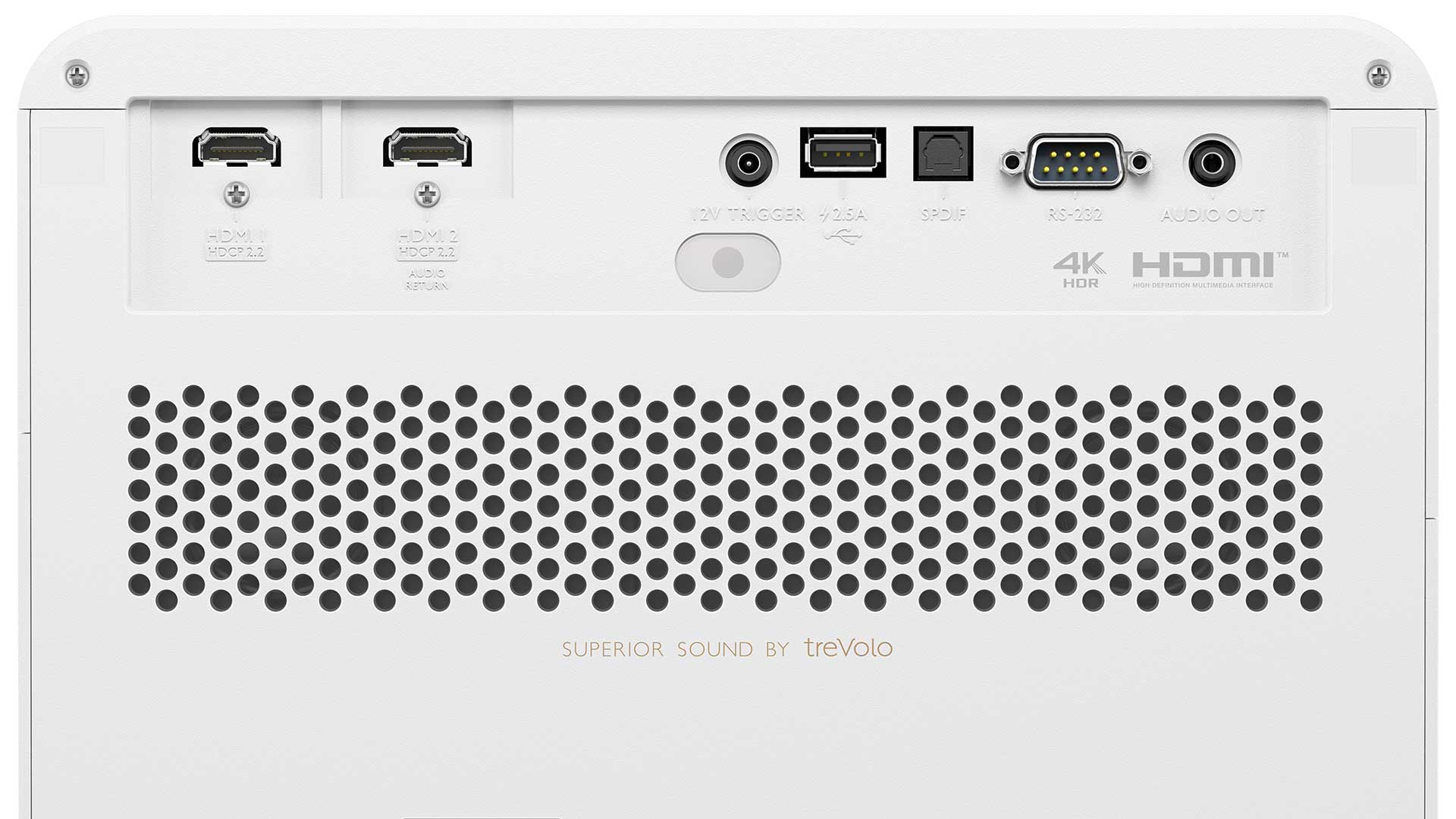
The image projected down from its lens height (or up from its height if the right way up on a table). The minimum distance for a 100-inch image is 2.5 metres, so for those in a deep lounge room, table positioning should be feasible.
Focus is manual, on a second side wheel next to the zoom; this ring is nicely weighted and responsive, so it’s easy to achieve accurate focus which stays accurate. A test screen of rectangles is available, which showed some small divergence of blue and green when viewed close-up.
If you can’t position the projector perfectly to achieve a true rectangle, there is keystone adjustment available, automatic if you wish. Using keystone adjustment remaps resolution and takes away some pixels, so it’s to be avoided if possible, though with UHD resolution you’ve got far more pixels to play with than on lesser projectors. There was no immediately obvious quality loss in doing so here, but we avoided it anyway!
Android stick
BenQ had already installed its QS01 Android stick under the flap in our sample of the X3000i; there’s an HDMI socket there and a USB slot to provide the dongle with power.
This is the same stick used in other BenQ projectors; according to BenQ’s literature it uses Android 9.0, but ours seemed to have been upgraded to version 10 (firmware 2.00.07), indicating useful upgradeabiity.
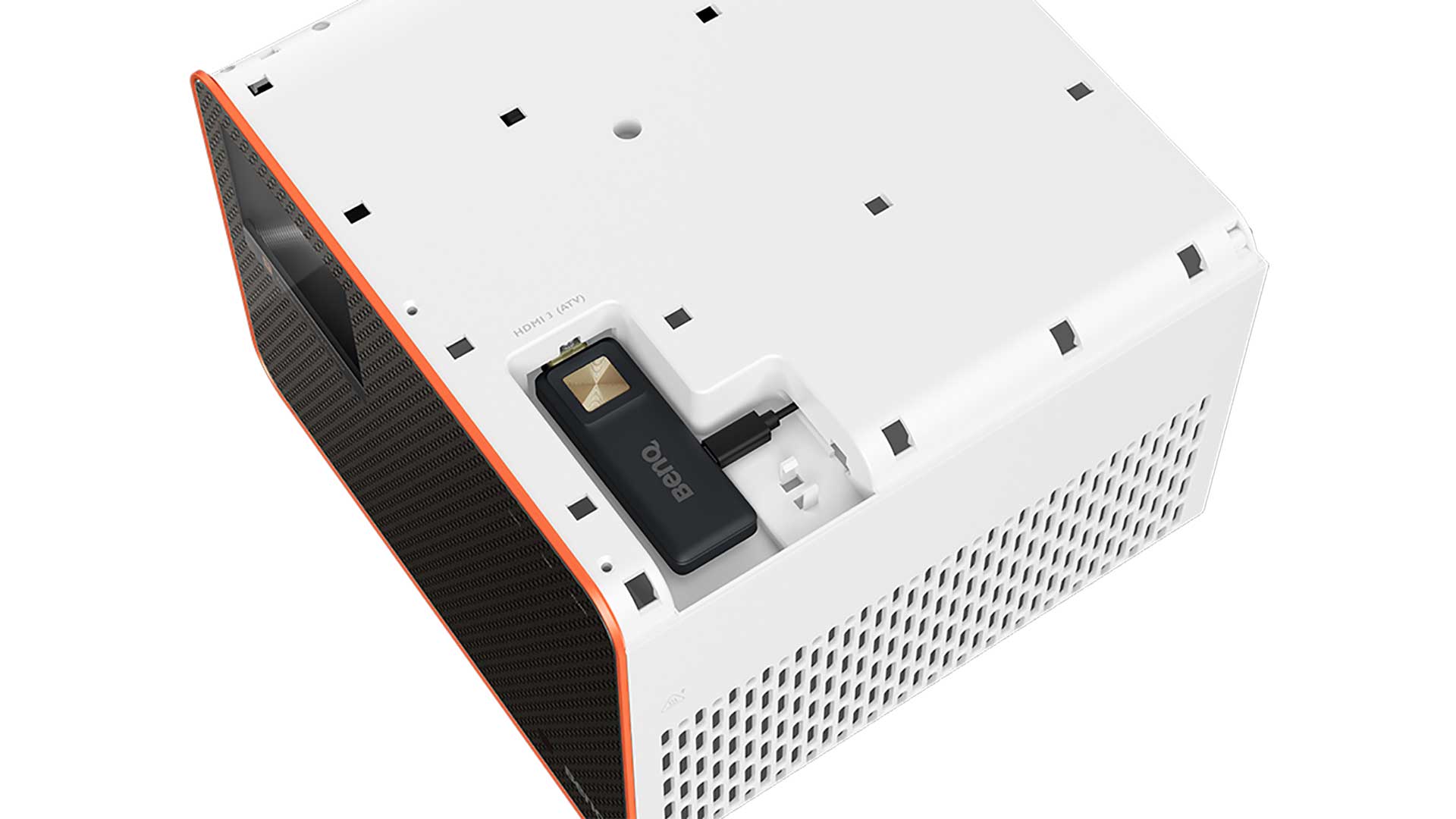
Once connected to your home Wi-Fi the stick makes available some 5000+ apps, BenQ says! For Australia this includes all the terrestrial catch-up channels, plus Disney+, Stan, Prime (with a direct access button on the remote), Binge, Kayo, Paramount+, Apple TV, Tubi, and many more. But not Netflix, a major omission though not BenQ’s fault – Netflix has been annoyingly slow at licensing its app for projector use (BenQ tells us that it is “in discussions”).
Meanwhile the QS01 can support Netflix via the included Wireless Projection app from a Chrome browser on another device, or more reliably, as we did, using a Netflix app on another device, plugged in via HDMI. We used a connected AppleTV 4K for this, and much more besides.
The other limitation of the QS01 is that it provides 60Hz output, so that on material recorded at 24 frames per second (movies) or 50Hz (Australian and European TV content), judder might be evident on long pans and rapid movement. So from Stan, a long pan across mountain ranges in the opening scenes of The Summit was notably juddery via the QS01 app – but rock-steady when played via cable from the Stan app on an AppleTV 4K (set to follow frame rate).
Having said that, the projector seems quite adept at damping down 50 to 60Hz conversion that the QS01 might perform on, say, ABC iView originals. Pans during Gardening Australia did have slight judder, but rarely enough to distract.
But you can ensure none of that by playing from an external source that can handle all frame rates natively, since the X3000i (and its DMD) are certainly capable of delivering all native frame rates – 24, 50 and 60, as well as the potential multiples for gaming. From an external input the projector indicated all frame rates correctly in the information pane that appears with each change of input.
Android also brings Chromecast, enabling you to ‘cast’ from a Chrome browser direct to the QS01. This casting ran smoothly for us (results will be network-dependent), though from Chrome on our Macbook Pro the casted resolution was much reduced, to a level where pixellation was evident. It’s far better to run an app on the QS01, or to use an external source (or computer) with a cabled HDMI connection.
The dongle also receives via AirPlay, something not offered by most Android dongles; from our MacBook Pro this delivered far superior results from a Chrome browser than had Chromecasting in terms of resolution, though it did re-introduce judder on the mountain pans of The Summit where none were visible on the screen doing the casting.
Having an Android TV interface also allows Google Voice Assistant and Voice Search, for which there is a voice button on the remote.
Colour and brightness
We’ve got this far without fully complementing the X3000i for its straightforward image quality. We spent some time optimising brightness and colour, but later, after we did a factory reset when trying to fix a remote control fail, we realised that BenQ’s colour performance is pretty much on the money out of the box.
And the overall image quality is magnificent. Colours are natural, yet full and vibrant; watch the intro to Gardening Australia for an outstanding example, or indeed pretty much any other scene, where the greens and the range of greens are wonderful, bright in the light, dulled in the shade, with red and purple blooms pinging out of the foliage.
Skin tones were never overpushed into red or browned out into sepias, and we found the only adjustments we were making were to drop the sharpness and tweak brightness and contrast between day and night viewing sessions. But there are full adjustments available for RGBCMYW hue, saturation and gain. Wide colour gamut requires a specific selection, and a relay clunk within the projector indicates this may re-configure the light path or colour wheel somehow.

We connected a Sony 4K Blu-ray player to enjoy UHD content without the variables and inevitable compression of streaming services; 4K LOTR remasters first, of course, to enjoy again the extraordinary detail in so many of its scenes.
As Gandalf plunges into the abyss of Khazad-dûm, there’s that magnificent CGI shot 3:35 into the Extended cut of The Two Towers where balrog and wizard fall through a vast cavern into water; the BenQ rendered this fastastically, like an art work, with the motion perfectly smooth and the detail sufficient to make out the tumbling demon, while the close-ups before and after are a wonder of flame and scattering embers.
The title sequence then pans across rocks and mountains with Sam and Frodo clambering down the extreme left of the image; again, what art! The edges were sharp, the rock shadows realistic (in a fantasy movie kinda way), and if there’s any CGI in this shot, well, we couldn’t pick it.
Needless to say we were caught up in such a fine bigscreen rendition of the movie and ended up watching long sections of it again – too good to miss! The details and colour during the scenes in the Golden Hall of Edoras were extraordinary, from the hanging tapestries to the gold braid of Theoden’s waistcoat.
When we switched to the UHD Blu-ray remaster of My Fair Lady there was no missing that the opening rainy scenes are all about the dresses emerging from the Opera House – such colours, such detail! There’s also a smoothness and strength to images here which may be attributable to the larger mirrors of that new DMD.
Just occasionally we missed having motion settings that might smooth certain scenes. It’s true that motion control settings are becoming out of fashion since Tom Cruise and massed directors came out against them, and certainly gamers wouldn’t want their creation of interrelated intermediate frames nor the processing delay this would incur.
But the lack does mean there’s no sympathetic smoothing of tricky moments, such as during the opening scenes of Apple+’s Severance series, where the main character walks down white corridors, and on horizontal movement there was some horizontal frame-ripping visible.
In LOTR some close-up pans over detailed ground could lose detail that motion smoothing might stabilise – such as in a pan over ground at 17:00 up to Aragorn listening for pursuit, or in My Fair Lady the pans around flowers in Covent Garden before Eliza and her father meet. But there was no conversion judder whatsover playing via HDMI.
There are two energy-saving modes (we nearly called them ‘lamp’ modes). ‘Eco’ simply drops the brightness level, which will be no great loss in small installations, while SmartEco adjusts the brightness dependent on the content on screen, adding a ‘Dynamic Black’ algorithm which aims to determine the appropriate light and black levels to fit scenes as they are processed.
We started off using ‘Normal’, but spent many hours trying SEco and SmartEco, and never did either deliver brightness, contrast, colours or blacks which fell below our threshold of acceptance, nor did we notice any pumping from Dynamic Black operation. Given the extended life this last option may deliver, we recommend trying it.
The 4LED’s output of 3000 lumens proved to be bright enough to watch with pretty much anything except direct sun hitting the screen. Obviously you won’t enjoy the full contrast performance in daylight or with the main lights on, but it’s more than watchable, with its full abilities in reserve for evening viewing. It provides, unsurprisingly, a huge contrast (pun intended) over the last BenQ we had in, the little GV30, with its output of a mere 300 lumens.
From Apple TV+ on the attached AppleTV 4K we played Joel Coen’s recent Macbeth with Denzel Washington and Frances McDormand, shot in black and white and streaming at 4K with Dolby Vision HDR, and Dolby Atmos audio available. The lack of colour – followed to the extent of nearly all the sets being built in monochrome – makes this a fine screener for HDR detail.
The BenQ autoselected its ‘HDR10’ mode, which offers five useful adjustments to HDR brightness. With the default middle settings, and even without dynamic Dolby Vision information available, the results were fine indeed; the shadows and darkness accompanying Banquo’s opening of Act 3 left him standing so forward of the screen the effect was almost three-dimensional, and everywhere there was detail displayed in the darkness, but also in the sheets of white mist that drift across the sky. It’s a great movie for setting your white and black levels!
Sound options
Built-in sound isn’t an ideal audio solution for a projector, even if it’s portable and sitting in front of you on a table. With a larger projector there’s potentially a bigger sound – but it will almost certainly be coming from behind you.
In a market when screen-emissive TV audio and upward-firing soundbars boast of mapping audio accurately to onscreen positions for a greater sense of reality, putting speakers in a projector behind you is about as unmapped as you could imagine.

Yet the brain is good at adapting to what you’ve got, and we ran a fair amount of casual material this way to hear what the speakers are capable of. We were able to sit directly in front of the projector’s ceiling position to allow it half a chance, since sitting to one side would defeat any attempt at stereo.
The audio system’s two “5W chamber speakers” both fire from the projector’s rear; they don’t offend, and even proved capable of some surprisingly effective moments. The bright fizz of the digital alarm which awakens Ryan Gosling from his flying car doze at the start of Bladerunner 2049 made us jump from our own calmed state invoked by the soporific cityscapes of the opening.
But male dialogue could be softened by bloom from the slight boxiness of the sound from the unit, which is inevitably ‘pushed’ in EQ to compensate for the lack of any real bass, while it’s hardly a wide spread of sound either, even if you press the top centre remote button to activate ‘dynamic stereo enhancement’.
This created a certain openness to soundscapes and soundtrack music without seemingly interfering with intelligibility, and is part of Bongiovi’s DPS (Digital Power Station) audio technology, “to simulate dynamic 3D sound, creating an immersive sound experience… a more surrounded, three-dimensional sound effect”.
Not really, no, but it had quite a widening effect in the right circumstances – the bees 1hr42 into Bladerunner 2049 offered a good example of this. There are other sound modes – ‘Cinema’ “which emphasizes deep bass”, Sports, “which emphasizes vocals”, and FPS, “which emphasizes virtual surround sound” (but again, not really).
The best thing you can do for your sound here is get it out of the box. Gamers may well be wearing headsets connected to the console anyway. Otherwise we’re delighted to see BenQ has included two levels of digital audio output in addition to an analogue minijack output.
There’s an optical output which can deliver up to 5.1-channel audio, and eARC available on the HDMI 2 socket from which you might send up to Dolby Atmos from one HDMI input out to a receiver to the other, though we weren’t able to test this.
So again, for the best results with sound, use an external source, and an external sound system. The quality of projection is such here that it demands no less. Do it properly.
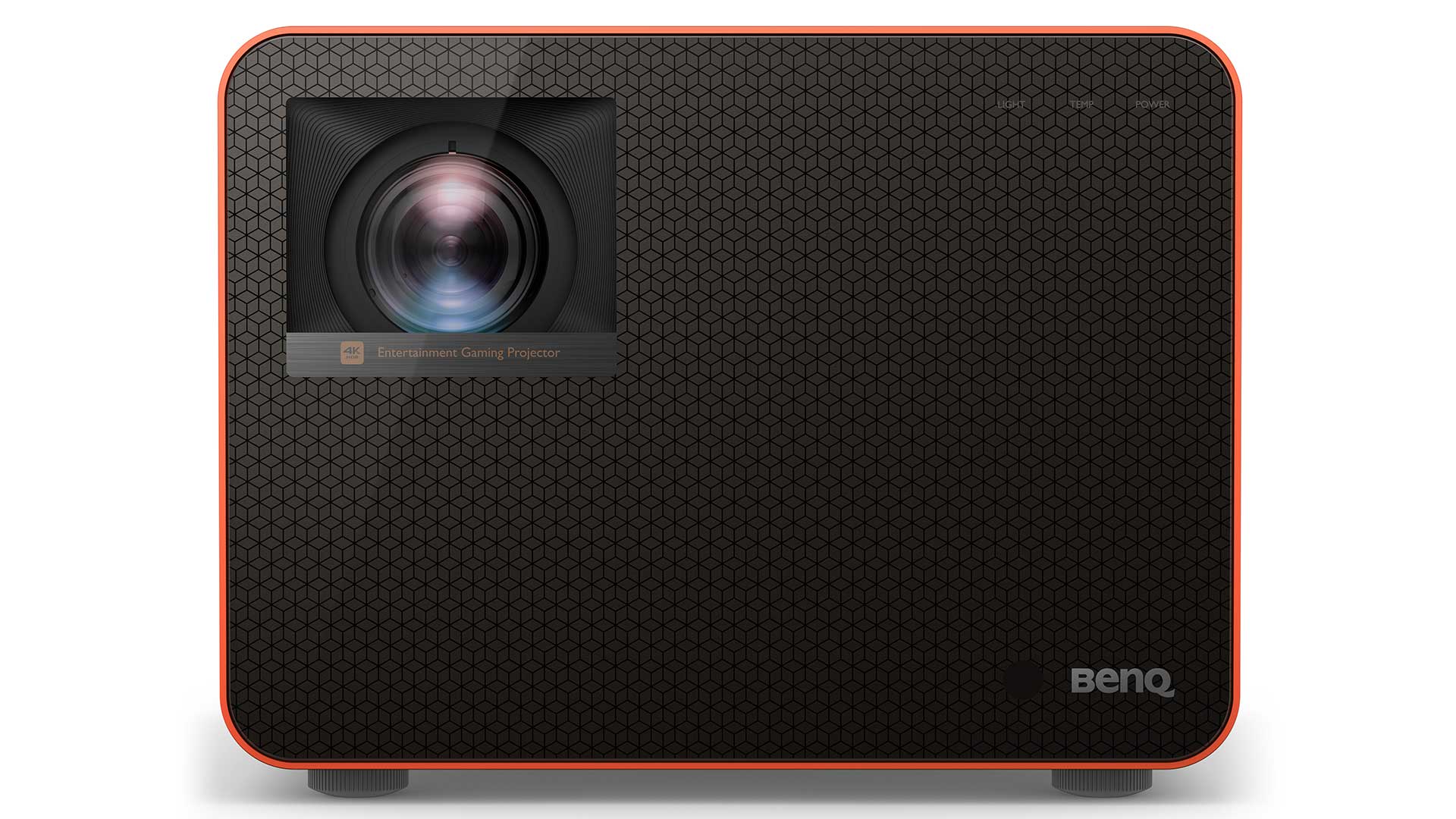
Final verdict
The apps and wireless streaming from the included QS01 Android dongle add great convenience to the X3000i projector in terms of access to services. But in a number of ways the highest available performance is unlocked by connecting via HDMI.
We’d also recommend an external sound system. Then you will unlock and ensure all the finest entertainment that this projector can deliver – genuine four-flash UHD resolution with qualities of detail, colour and brightness beyond the price level here, whether you’re settling back to enjoy a movie or TV series, or leaning forward into a gaming adventure. For our money this is hands-down the best four-flash UHD projector BenQ has yet delivered.

Jez is the Editor of Sound+Image magazine, having inhabited that role since 2006, more or less a lustrum after departing his UK homeland to adopt an additional nationality under the more favourable climes and skies of Australia. Prior to his desertion he was Editor of the UK's Stuff magazine, and before that Editor of What Hi-Fi? magazine, and before that of the erstwhile Audiophile magazine and of Electronics Today International. He makes music as well as enjoying it, is alarmingly wedded to the notion that Led Zeppelin remains the highest point of rock'n'roll yet attained, though remains willing to assess modern pretenders. He lives in a modest shack on Sydney's Northern Beaches with his Canadian wife Deanna, a rescue greyhound called Jewels, and an assortment of changing wildlife under care. If you're seeking his articles by clicking this profile, you'll see far more of them by switching to the Australian version of WHF.
